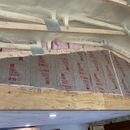Help with insulating gable wall adjacent to attic space
<picture attached> My contractor insulated this “challenging” gable wall in a way that I’m not overly excited with. Mainly the way the upper portion was done using faced batts folder over and stuffed in to the stud bay. The back side of this wall is open to the previous roof (it’s an addition) so faced insulation was needed to hold the batt in place. These faced batts couldn’t be run the entire length of the stud bay because of interference by the end roof truss. In hindsight, this should’ve been sprayed when the cathedral roof but that’s hindsight now. To improve the air seal and add some R value, I was considering the idea of installing Polyiso sheets over the existing insulation before finishing the wall with T&G wood… but uncertain if doing so might create vapor/moisture issues. Is it OK to install Polyiso over the faced batts? What about where the batts are seemingly just folded into the short gap that was remaining above the bottom chord of the truss? My thought was I could spray foam (Great Stuff) the edge of the Polyiso where it meets the ceiling for air/vapor seal. Contractor seems to think it is perfectly adequate the way it is but I know there is no vapor seal at the top the way it is!
GBA Detail Library
A collection of one thousand construction details organized by climate and house part










Replies
I think you'd be fine with polyiso installed as you propose. I might try cutting some polyiso and installing it behind the framing too in place of those squished-in batts, but I'd have to see the space in person to know if that would really help. I don't think you'd have any moisture issues since the polyiso would help keep moisture from getting into the space behind it, and I expect there are other areas in that space that would allow for some drying, so the polyiso isn't the only way for any moisture that sneaks back there to "get out". I would use caulk to seal the polyiso to the framing around the perimeter BEHIND the polyiso, then use canned foam around the edges to fill in any larger gaps. You'll want to tape the seams between panels.
BTW, I've done exactly what you're describing here in part of my own home and it worked fine. I used leftover XPS instead of polyiso, but the concept is the same. Try to match the thickness of the foam board to the thickness of the framing if you'll be going edge-to-edge so that you end up with a flat surface, which then makes it easy to either add second layer of foamboard (which is what I did since I didn't use any batts in my installation), or you can put your T+G right over the foamboard.
Bill
Hey Bill, is acoustical sealant which is often used for sealing poly at the perimeter in my area a good caulking product to use for this purpose with the polyiso? Or would a hardening door/window caulk be better since it also acts as an adhesive? The acoustical is non-drying/non-hardening.
I try to avoid acoustical sealant as much as possible, since it's permanently messy stuff. You only really need it when you have things you know are going to move over time, since acoustical sealant won't crack, since it never hardens.
For something that won't move, or won't move much, just use a stretchy caulk. I usually use polyurethane sealants from Loctite's PL line for this, since they are very durable, very sticky, and readily available.
Bill